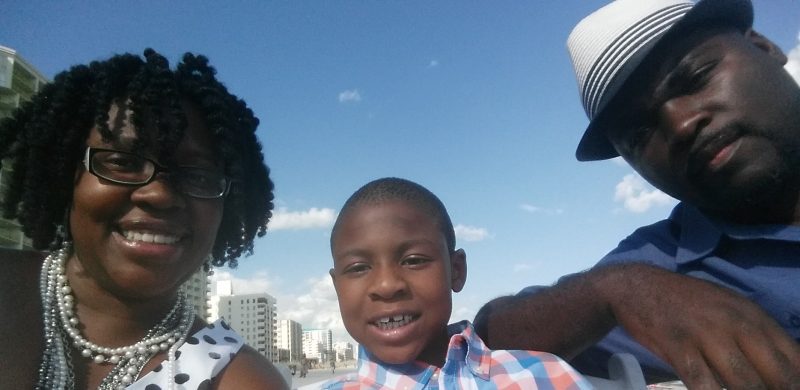
Amber Wilkes-Smith with her husband and their son
Black Lives Matter! A rallying cry to address the unjustifiable killing of people of color and the public’s disregard and avoidance of the reasons that racist violence remains rooted in our society. Media outlets are primarily reporting on police brutality, as they should; however systemic racism is pervasive in all American institutions, including child welfare. Every institutional encounter places the Black family at risk of separation. From public school teachers, medical staff, public housing, social services and the police, Black families cannot avoid scrutiny nor find relief or justice.
Daniel Patrick Moynihan was a white American scholar and politician who in 1965 co-wrote the controversial report, “The Negro Family: The Case for National Action”, popularly known as “The Moynihan Report”. Moynihan argued the U.S. government underestimates how 300 years of “unimaginable mistreatment” wreaked havoc on the Black people and how breaking up the Black family obstructs its progression, stating that “the racist virus in the American blood stream still afflicts us.” To me, Moynihan provided prescient insight, noting that Black youth are caught in the trap of poverty and systemic oppression, writing: “Many of those who escape do so for one generation only and their children may have to run the gauntlet all over again. This is not the least vicious aspect of the world that white America has made for the Negro.”
Moynihan’s words resonate deeply with me almost 60 years later.
History Repeated
My niece has been in foster care in Erie County, NY for five years and will now be adopted by non-relatives. In violation of our family’s rights, I was never notified by the child welfare system that she was in care. Two years ago, her mother notified me of her daughter’s placement in a foster home. At that point, my niece had been in foster care for three years and my sister was in the process of appealing the termination of her parental rights. I filed a custody petition in Family Court and filed complaints with the County Commissioner of Social Services and the New York Office of Children and Family Services. When the petition was dismissed, I filed an appeal through the appellate court. While the appellate court verbally noted that the Erie County Department of Social Services (ECDSS) violated section 1017 of the Family Court Act, the court upheld the Family Court’s decision on a technicality—that I should have sought adoption rather than custody – ignoring the contradictory fact that I would have sought adoption if ECDSS had contacted me as required and advised to do so.
My niece’s removal to foster care was a direct outcome of the ramifications of slavery and institutional racism. This statement may sound alarmist; however, my niece is only six generations removed from slavery, two generations removed from Jim Crow, and is a third generation experiencing the disruption of our family by the child welfare system.
My mother spent time in an orphanage when her mother, my grandmother, found it difficult to provide for her children in Jim Crow South Carolina. In an ironic twist, the lack of governmental intrusion and segregation permitted my grandmother to regain custody of her children and relocate to New York. Yet the trauma inflicted on my mother and her siblings during their time in the orphanage was unbearable. During those times, and especially in the South, there was no economic relief for poor Black families. It was near impossible to even think of locating a psychiatrist for therapy. Black families had to suffer the economic burden and mental anguish of racial strife without support. Black parents had to raise their children in an unforgiving society that despised them and figure out how to navigate systems that would incarcerate, sterilize and even murder them.
My mother was unwed with eight children and by all standards lived at or below the poverty level, as had the matriarchs who preceded her. I don’t have any traumatic memories from my time residing with my biological family. Instead, I remember cooking and dancing with my mom, learning Spanish and going to visit the library with my mother carrying snacks for my sister and I in her purse. I can even faintly recall the smell of her saliva as she used it to wipe a smudge off my face. I remember being happy.
My mother was 42 years old when my sister and I, ages 3 and 4, were removed from her care, allegedly due to neglect. I later learned that I had aunts, uncles, older siblings and cousins who resided less than five miles from the foster home we remained in for over four years before we were adopted. So close, yet so far. What would it have taken to keep my family intact? I imagine the monthly subsidy the state provided my foster parents would have helped my mother or other relatives with food, childcare, clothing and maybe a more suitable home in a safer neighborhood. Despite the trauma my family faced from the disruption and lack of familial reunification, lessons went unlearned by the system. History repeated itself a generation later when my niece entered foster care.
Violations Ignored
According to the New York Office of Children and Family Services’ (OCFS) Children in Care and Custody (All Statuses) Report as of March 31, 2020, 52% of children in State care are African American despite African Americans accounting for only 17.6% of the State’s population. These statistics are a glimpse of a grim assessment.
Section 1017 of the New York State Family Court Act (FCA) states that when the court determines that a child must be removed from their home, social services must conduct an immediate investigation to locate any relatives of the child and inform them in writing of the pending proceeding and of the opportunity to become foster parents. In addition, social services must report the results of this investigation to the court and record the results of the investigation. This is the first step in the process and is required to occur 100% of the time.
Unfortunately, this did not occur for my family. Despite having access to Google, social media and prior case management files that included my contact information, social services provided the court with an incomplete investigation and incorrect information, thus violating Section 1017.
This violation was ignored by the caseworker, her direct supervisor and ultimately the court. What caused this failing to occur continuously at every level for the first three years of my niece’s life? Why was it so easy for social services to ignore our family’s right to remain intact? How many other families has this happened to? Unfortunately, these questions will remain unanswered, as Family Court dismissed my case and denied me a hearing.
I appealed the ruling and on June 25, 2020, my attorney argued our case before a New York State appellate court. While the justices confirmed social services violated Section 1017, they further noted that procedurally, this case should have been presented prior to the termination of parental rights. But how could I present a case if social services failed to provide notification? It pained me to listen to one of the justices repeat back the false, misleading information social services noted in the case file.
On July 17, 2020 the appellate court ruled against me by upholding the Family Court’s dismissal of my petition. The appellate court’s lack of courage to challenge this institution and hold Erie County DSS accountable essentially means child welfare agencies can now act with impunity and continue to completely disregard the rights of families and the rights of children in their care.
Incorrect and misleading information goes to the heart of my case and goes beyond my individual case. These issues were recently identified in an audit report released by the Office of the New York State Comptroller on March 2, 2020 which found that “direct placement cases lacked evidence that the Local District provided the courts with all critical information, which the courts rely on to make decisions.” In addition, the report noted the inadequacy of entries in the system’s database: “Direct placement data in CONNECTIONS was not always complete or accurate, which may compromise its integrity and usefulness.” Both findings have real-life consequences for families, as missing contact information and investigation details for relatives who were willing to provide care resulted in a lengthy placement for my niece in foster care and now the permanent separation from her family.
Loss of Resources
Being denied the right to keep my family intact isn’t the only undue burden placed upon us. There is an economic burden, as well. Challenging an unjust judicial decision can cost thousands of dollars. My family used our personal savings to hire two attorneys. When the median net worth of a Black family in America is $17,150 in contrast to $171,000 for white families, pursuing legal interventions is simply cost prohibitive for many Black families. Wealth that could have been invested in our family has been deposited into a biased judicial system that provides no equitable rate of return, thus creating further generational harm through loss of resources.
As our family grieves the diminished prospects of being reunited with our niece and will carry the anger, anguish, and frustration over the judicial rulings and institutional failures for many years to come, I recall how Moynihan 55 years ago understood the root cause of the plight of Black families – slavery.
“It was by destroying the Negro family under slavery that white America broke the will of the Negro people. Although that will has reasserted itself in our time, it is a resurgence doomed to frustration unless the viability of the Negro family is restored.
The policy of the United States is to bring the Negro American to full and equal sharing in the responsibilities and rewards of citizenship. To this end, the programs of the Federal government bearing on this objective shall be designed to have the effect, directly or indirectly, of enhancing the stability and resources of the Negro American family.”
As a society we must rethink how we can rework social programs to aid those who need assistance in our communities. Ensuring that all families have adequate resources to raise their children in a safe, healthy environment—and holding child welfare agencies accountable for their inadequacies—is a start. Legislative change is needed to achieve this. For instance, parents and advocates in Minnesota recognized the need to prevent separation of families disproportionately impacted by foster care placements and have fought for the passage of the African American Family Preservation Act. I challenge New York State legislators to act immediately and sponsor similar legislation.
Black lives matter and Black families do too!
Read the Rise interview with Amber Wilkes-Smith and Michael Steinberg, her lawyer in the appeal.
